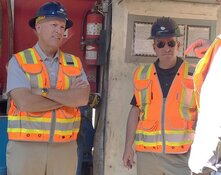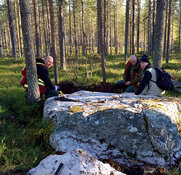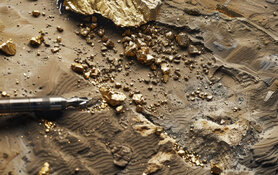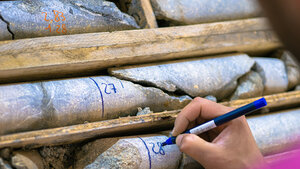The Gold Report: After the Prospectors and Developers Association of Canada Convention in March, you said that the next 12–18 months could define how investors, speculators and mining companies perceive and value both the junior and major mining sectors. That was before the volatility of mid-April. With higher production costs being the new normal, what percentage of miners can make money at the current gold price?
Brent Cook: That is a tough call because companies use different methods to report their gold prices and gold costs. Cash costs are just one factor. When you throw in exploration, general and administrative expenses, royalties and such, it goes up quite a bit.
Everything I have seen published by both the companies and the analysts suggests that the all-in average cost of production for larger mining companies is in the $1,300–1,500/ounce range. That is a tight margin at the current price. Companies are cutting back on exploration and capital expenses (capex). That may help in the short run, but it will not solve the problem.
I wrote an article called "Mining Meets the New Normal," in which I discuss the thesis that the mining companies are turning inward on their own little mines. Their expectation seems to be that by tweaking the way they operate, they can cut costs and turn their mines into slightly more profitable mines. They believe they can squeeze out the last bit of blood from the rock, if you will.
TGR: While that kind of cutting back can help in the short term, what are the long-term implications? If companies are not exploring, where will the new gold come from in 5 to 10 years?
BC: Precisely my point. Companies are concentrating on their current deposits, trying to add ounces at their operations. For me, that means they will have to go deeper or bring in more low-grade rock. Both of those mean higher costs—higher strip ratios for an open pit, and more development costs for an underground mine. They may add more ounces, but in at least 80% of the deposits the grades will probably decrease, unless they up the cutoff grade, which then puts them back in the same predicament. That actually means their costs will increase and/or production will decrease.
In the next year and beyond, the large mining companies will realize this strategy is not making them money. They will have to find, acquire and develop new, high-margin deposits. Very few of those are left, and they are hard to find. Once found, they take a long time to develop. The large mining companies will have to buy the high-margin deposits that are being discovered and proven up by others.
That is my focus: the new discoveries that will be the best-of-the best deposits in the world that someone will have to own. That is what Quinton Hennigh—an excellent geologist working with me at Exploration Insights—and I are good at, and there is less competition in that space right now.
TGR: Can geophysical surveys make it easier to find new sources or does it still take a drill bit and a smart geologist to interpret the results?
BC: Technology can, and does, help. Geophysics helps us see deeper into the earth. We are also using mobile metal elements for sampling, along with more detailed and precise geochemical methods. Technology helps, but it does not solve the issue of actually finding these new deposits. Geophysics measures the geophysical difference between one rock type and another; it does not tell you anything about grade.
It still comes down to drilling. And it takes a good geologist with an imagination to interpret data and decide where to go. This is a very inexact science. In fact, it is half science, half art and half luck.
TGR: How do you determine the difference between an anomaly and an economic deposit?
BC: That is the hard part. That takes tens of millions of dollars and is what a feasibility study is all about.
Explorers run around the world, finding and evaluating anomalies. The earth has been evolving and changing over its 4.6 billion year history. As it changes, those changes are reflected in geochemical and geophysical anomalies. A volcano blows up and washes away, hot springs come from a cooling magma and change a hard rock to clay; that process happens all the time and creates geochemical anomalies. Maybe one in one thousand of those geochemical anomalies might reflect an economic deposit.
Determining which is a deposit requires going through the feasibility study process, looking at metallurgy, infrastructure, rock mechanics, at everything that goes into building a mine. We really try to turn an anomaly into an ore deposit through detailed studies that cost a lot of money.
"It takes a good geologist with an imagination to interpret data and decide where to go. This is a very inexact science."
TGR: As holes are drilled and press releases highlight the drill results, share prices often drop, whether the results are good or bad. Why is that? What should people look for in the announcement of drill results to determine whether the price should go up or down?
BC: If you are going to invest in the explorer/speculative companies, it comes down to knowing what a company is looking for. Is it looking for porphyry copper, high sulphidation, whatever? You need to know what that looks like in terms of size and grade. Then you need to understand what the results tell you, relative to the expectations. Are the grades sufficient to warrant mining or are they too low? If the mineralogy of the deposit tells you that it is, for example, a high-sulfidation system with a lot of arsenic, antimony and mercury, you know it will be troublesome, if not impossible, to get the gold out of it economically.
You need to evaluate each drill hole keeping in mind what you expect the company to find.
To do that, you really almost have to be an expert. Otherwise, you are looking at a drill result and saying, "Wow, that is fantastic" or "Wow, that is no good." Twenty meters of 2 grams per tonne (2 g/t) could be a fantastic result or a really poor result if you do not put it into context.
TGR: Do share prices go down on good drill results because people are confused, or is something else going on?
BC: It varies. Right now, the market is so messed up that people are reacting without thinking. I have seen drill results that I think are good, and the stock will go down because people were expecting better or were just looking for an excuse to sell regardless of the results.
I have seen results that I think are really poor, and the stock goes up because people do not recognize that the company has drilled right down a structure and it is not nearly as thick, as wide or as good as it appears to be in the press release. People are not interpreting the results. They are being too reactive to market influences instead of analyzing what it really means.
TGR: What are some red flags in drill results press releases that make you look twice?
BC: One thing to look for is grade smearing. I have a tool that Corebox and I developed called the Drill Interval Calculator that lets investors calculate how much grade is being smeared across how much drill core. For example, a company will drill a 1-meter (1m) high-grade interval, call it 30 g/t, and mathematically smear that across 30m so it looks as though it has a 30m interval of 1 g/t. That is an extreme example, but it happens. The significance is that it changes what the deposit might be. Thirty meters is a lot wider and may be better because it implies a whole different set of economics and possible tonnes. Using the Drill Interval Calculator you can plug in the big interval and the little interval and see what the remaining rock really grades. Sometimes that can be quite interesting.
Investors also need to see if the press release gives them all the information they need to interpret the data. Investors should expect a drill hole map—including all the past drill holes—and a drill section that shows what it looks like in sections. If a company is not releasing those data, it says one of two things: It is either incompetent or is trying to hide something. In both instances, it is not a company you want to own.
There should be a real easy summary that anyone can read, but you should also be able to dig into the details and decipher what is going on.
The good companies— Almaden Minerals Ltd. (AMM:TSX; AAU:NYSE) and GoldQuest Mining Corp. (GQC:TSX.V) do this well. They provide drill maps, sections and the entire drill hole assay database. That is the kind of company you want to be involved with.
TGR: What are some recent examples of drill results that should be positive catalysts for stocks?
BC: Colorado Resources Ltd. (CXO:TSX.V) put out a fantastic hole, and the stock went from $0.19 to over $1/share.
TGR: What did you like about that one?
"It is a good time to get into the market, as long as you know what you are buying, why and what it is worth."
BC: It is 230m of more than 1 g/t gold equivalent, copper and gold, indicating that the company might be onto a high-grade porphyry copper deposit. We will have to wait and see, but it is a very good drill hole. Right now everyone who owns that stock should have in the back of their minds the tonnes and grade that will make this economic. They should also understand what the variability of these deposits is like, so as not to misinterpret the results.
TGR: What about other companies?
BC: Atico Mining Corp. (ATY:TSX.; ATCMF:OTCBB) issued a release not long ago on its volcanogenic massive sulfide (VMS) system in Colombia. The company had some very good results and is certainly economic. What remains to be seen is the potential size.
TGR: Are there any other companies you would like to talk about?
BC: Last week I bought Roxgold Inc. (ROG:TSX.V), after following it for a long time. The company will issue a preliminary economic assessment later this year. Its Burkina Faso deposit is not big, but it is tight and high grade. It will be easy to mine, inexpensive to build and very profitable for whoever ends up owning it.
TGR: Is your investment thesis changing given how hard it is for companies to find funding and how volatile the gold price has been? What are you doing differently? What are you looking for now compared to six months or a year ago?
BC: I remain focused on the economics and on grade. I am looking for what the larger mining companies are going to be buying. That is what I want to own and what I have bought.
TGR: Does that mean you are looking for companies that are acquisition targets?
BC: Exactly. I am looking for two things: real early-stage discoveries and companies that offer high margins. There are not many out there.
TGR: You recently published a list of mid-size and large companies that fit your investment criteria. How did you compile that list?
BC: Quinton Hennigh and I went through all the deposits we were familiar with and tried to get some sort of valuation on them before a feasibility study and such had been done on the deposits. We came up with a list of large and mid-sized deposits that are high margin—deposits we think major mining companies will want to buy.
TGR: One of the companies that fits those criteria was Lydian International Ltd. (LYD:TSX). What can you tell us about it?
BC: Anyone who follows me knows that Lydian has been on the list a long time. We bought that after I visited the project many years ago before the discovery was confirmed. I like it because it is a simple deposit. The mine will be simple to build and relatively low cost. Production costs are low. Its feasibility study shows it is worth something on the order of $1 billion and the mine can be built for $260 million today.
Mining companies will be looking for this kind of simple, low-capex project.
TGR: Any final words of wisdom for investors trying to preserve, if not grow, their wealth in this market?
BC: Gold is a good sector to be in, and the timing right now is good, in that the key to selling high is buying low. I think we would all agree that things are getting pretty damn low right now. I expect this to continue for some time and would be very conservative in what to buy. I see no urgency to buy anything, unless it is a true discovery.
TGR: Is it at the bottom?
BC: I do not think so, although we are very low in the trench. Two or three years from now, the deposits that are selling for pennies on the dollar today will be worth $1 on the dollar. That is what you want to buy.
I think it is a good time to get into the market, as long as you know what you are buying, why and what it is worth. As I said, however, I suspect things will stay rough for a while and for the most part there is no urgency.
TGR: Brent, thank you for your time and insights.
Brent Cook brings more than 30 years of experience to his role as a geologist, consultant and investment adviser. His knowledge spans all areas of the mining business, from the conceptual stage through detailed technical and financial modeling related to mine development and production. Brent's weekly Exploration Insights newsletter focuses on early discovery, high-reward opportunities, primarily among junior mining and exploration companies.
Want to read more Gold Report interviews like this? Sign up for our free e-newsletter, and you'll learn when new articles have been published. To see a list of recent interviews with industry analysts and commentators, visit our Streetwise Interviews page.
DISCLOSURE:
1) JT Long conducted this interview for The Gold Report and provides services to The Gold Report as an employee. She or her family own shares of the following companies mentioned in this interview: None.
2) The following companies mentioned in the interview are sponsors of The Gold Report: Almaden Metals Ltd., Atico Mining Corp., Roxgold Inc. and Lydian International Ltd. Streetwise Reports does not accept stock in exchange for its services or as sponsorship payment.
3) Brent Cook: I or my family own shares of the following companies mentioned in this interview: Almaden Metals Ltd., Roxgold Inc., Lydian International Ltd. and Colorado Resources Ltd. I personally am or my family is paid by the following companies mentioned in this interview: None. My company has a financial relationship with the following companies mentioned in this interview: None. I was not paid by Streetwise Reports for participating in this interview. Comments and opinions expressed are my own comments and opinions. I had the opportunity to review the interview for accuracy as of the date of the interview and am responsible for the content of the interview.
4) Interviews are edited for clarity. Streetwise Reports does not make editorial comments or change experts' statements without their consent.
5) The interview does not constitute investment advice. Each reader is encouraged to consult with his or her individual financial professional and any action a reader takes as a result of information presented here is his or her own responsibility. By opening this page, each reader accepts and agrees to Streetwise Reports' terms of use and full legal disclaimer.
6) From time to time, Streetwise Reports LLC and its directors, officers, employees or members of their families, as well as persons interviewed for articles and interviews on the site, may have a long or short position in securities mentioned and may make purchases and/or sales of those securities in the open market or otherwise.








































